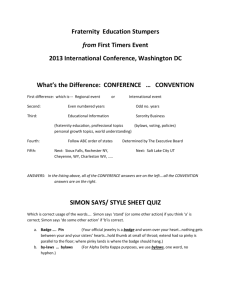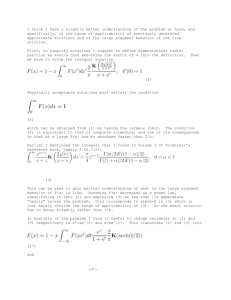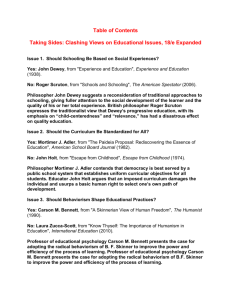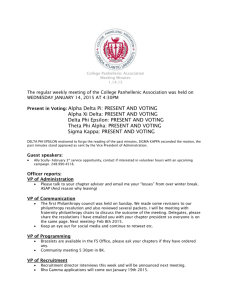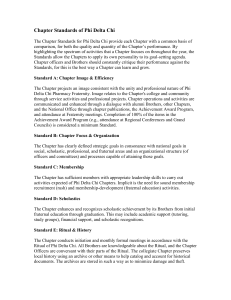Reference List - Career Account Web Pages
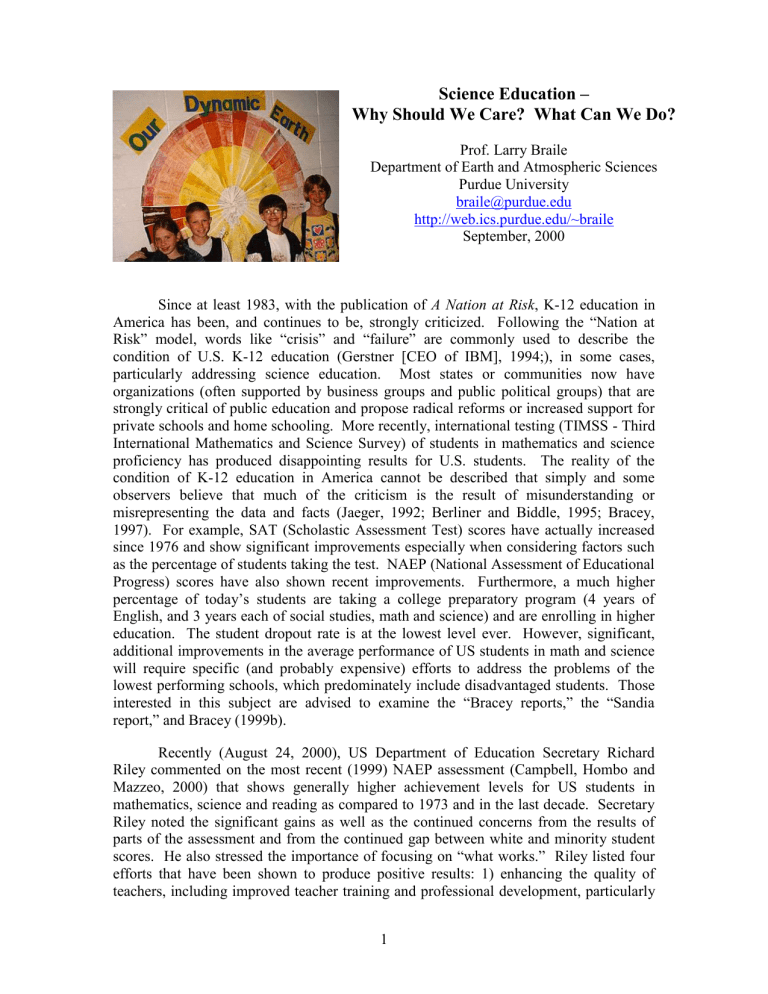
Science Education –
Why Should We Care? What Can We Do?
Prof. Larry Braile
Department of Earth and Atmospheric Sciences
Purdue University braile@purdue.edu
http://web.ics.purdue.edu/~braile
September, 2000
Since at least 1983, with the publication of A Nation at Risk , K-12 education in
America has been, and continues to be, strongly criticized. Following the “Nation at
Risk” model, words like “crisis” and “failure” are commonly used to describe the condition of U.S. K-12 education (Gerstner [CEO of IBM], 1994;), in some cases, particularly addressing science education. Most states or communities now have organizations (often supported by business groups and public political groups) that are strongly critical of public education and propose radical reforms or increased support for private schools and home schooling. More recently, international testing (TIMSS - Third
International Mathematics and Science Survey) of students in mathematics and science proficiency has produced disappointing results for U.S. students. The reality of the condition of K-12 education in America cannot be described that simply and some observers believe that much of the criticism is the result of misunderstanding or misrepresenting the data and facts (Jaeger, 1992; Berliner and Biddle, 1995; Bracey,
1997). For example, SAT (Scholastic Assessment Test) scores have actually increased since 1976 and show significant improvements especially when considering factors such as the percentage of students taking the test. NAEP (National Assessment of Educational
Progress) scores have also shown recent improvements. Furthermore, a much higher percentage of today’s students are taking a college preparatory program (4 years of
English, and 3 years each of social studies, math and science) and are enrolling in higher education. The student dropout rate is at the lowest level ever. However, significant, additional improvements in the average performance of US students in math and science will require specific (and probably expensive) efforts to address the problems of the lowest performing schools, which predominately include disadvantaged students. Those interested in this subject are advised to examine the “Bracey reports,” the “Sandia report,” and Bracey (1999b).
Recently (August 24, 2000), US Department of Education Secretary Richard
Riley commented on the most recent (1999) NAEP assessment (Campbell, Hombo and
Mazzeo, 2000) that shows generally higher achievement levels for US students in mathematics, science and reading as compared to 1973 and in the last decade. Secretary
Riley noted the significant gains as well as the continued concerns from the results of parts of the assessment and from the continued gap between white and minority student scores. He also stressed the importance of focusing on “what works.” Riley listed four efforts that have been shown to produce positive results: 1) enhancing the quality of teachers, including improved teacher training and professional development, particularly
1
for teachers teaching out of field; 2) thirty minutes of reading at home with young students; 3) implementing high standards, including offering challenging courses, high expectations and offering advanced and AP courses; and 4) school reform efforts, including smaller class size, increased early childhood education, and extended learning opportunities such as after school and summer programs.
A result of the criticism that K-12 education in America has received is a movement to reform our educational system and approach (National Education Goals
Panel, 1997; Templeton, 1997). However, potential problems (unintended consequences) associated with reform movements include: (1) lack of consensus on the direction that educational reform should take, (2) throwing out the good with the bad, (3) the
(mis)perception that our schools are failing, (4) reduced public support for schools, and
(5) reduced teacher morale.
Reform efforts in science education have been addressed by government agencies, scientific societies, universities, and teacher organizations. Major trends in the reform efforts are the emphases of “hands-on” and inquiry methods and the recognition that not every topic in science can be adequately learned and, therefore, it is better to teach a limited number of fundamental concepts better (the “less is more” concept). Science education guidelines have been produced by the National Research Council of the
National Academy of Sciences (National Science Education Standards), the American
Association for the Advancement of Science (Project 2061; Science for All Americans, and Benchmarks for Science Literacy), and the National Science Teachers Association
(Scope, Sequence and Coordination) (Joint statement of NAS, AAAS and NSTA, 1996).
The National Science Education Standards call for: science learning and literacy for ALL students, science teaching (including Earth science) at all levels, a reduced emphasis on memorizing facts and an increased emphasis on inquiry-based approaches which involve students in “doing science,” and improvements in professional development for teachers, assessment methods and educational systems. Navarro and Natalicio (1999) describe a particularly successful educational reform effort in El Paso, Texas schools.
Scientists and science educators can contribute to improving K-12 and undergraduate science education by providing opportunities for professional development for teachers and courses for pre-service teachers. From 1995-99, we conducted an intensive, 4-week, summer program (EPIcenter – Earth Processes Instruction Center) for science teachers. The workshops and related follow-up meetings and activities involved
30 teachers from mid-western states each summer. The project was sponsored by
NSF/EHR. The program was a partnership between scientists, science educators and experienced teachers (“master teachers”). Earth science topics covered during the workshop were: Earth history, topographic and geologic maps, hydrology, plate tectonics, earthquakes and volcanoes. Workshop activities included: Earth science content and teaching strategy sessions, discussions of standards and current reform efforts, field trips, development of specific lesson and implementation plans for each teacher, and experience with technology. Participant evaluations indicate that the program was highly successful. Several teachers referred to the EPIcenter program as a “life-changing experience.” The most significant impacts of the program on the teachers were improved
2
content area knowledge, increased awareness and understanding of teaching strategies and standards (the importance of inquiry and constructivism in learning), enhanced leadership abilities, and “boosting confidence.” Through the participation of scientists and science educators in professional development workshops and undergraduate courses, it is possible to impact large numbers of K-12 teachers and students and to improve science education in accordance with the NSES.
A National Research Council panel (Brunkhorst and Lewis, 2000) recently issued a report that urges increased cooperation between universities and K-12 schools in teacher education and professional development for teachers of science and mathematics.
The report has four major recommendations: 1) educate teachers of science, mathematics and technology throughout their careers (professional development); 2) raise the status of teachers through rewards, incentives and expectations; 3) hold colleges and universities more accountable for educating teachers; and 4) involve more scientists, mathematicians and engineers in local and national teacher education.
Undergraduate science education has also been under increasing scrutiny (NRC,
“From Analysis to Action,” 1996; NSF, “Shaping the Future,” 1996; Fox, 1998; Boyer
Report, 1998) and recommendations have been made for improving undergraduate science education (Boyer Report, 1998; NRC, “Science Teaching Reconsidered,” 1997;
Committee on Undergraduate Science Education, NRC, 1999).
Scientists, engineers and science educators should be interested in science education and improving science education at all levels for the following reasons: 1) to prepare some students for future careers in science and engineering, 2) to enhance science literacy of all students and of the public which will improve our society’s ability to succeed in an increasingly complex and technological world, 3) to increase public support for science, 4) to increase the capability in science of future teachers, and 5) because contributing to science education can be educational (for the scientist or engineer, as well as teachers and students), challenging, and fun!
Reference List
American Association for the Advancement of Science-Project 2061, Science for All
Americans , Oxford University Press, New York, 272 pp., 1990.
American Association for the Advancement of Science-Project 2061, Benchmarks for
Science Literacy , Oxford University Press, New York, 418 pp., 1993.
American Geophysical Union, Shaping the Future of Undergraduate Earth Science
Education , Workshop held November 14-17, 1996, Washington, DC, 61 pp.,
1996.
Atkin, J.M., and P. Black, Policy perils of international comparisons: The TIMSS case,
Phi Delta Kappan , 22-28, September, 1997.
3
Bell, T.H., Reflections one decade after a nation at risk, Phi Delta Kappan , 592-597,
April, 1993.
Berliner, D.C., and B.J. Biddle, The Manufactured Crisis: Myths, Frauds, and the Attack on America’s Public Schools
, Addison-Wesley, Reading, MA, 1995.
Bracey, G.W., Why can’t they be like we were?,
Phi Delta Kappan , 104-117, October
1991. [First “Bracey Report”].
Bracey, G.W., The condition of public education, Phi Delta Kappan , 104-117, October
1992. [Second “Bracey Report”].
Bracey, G.W., A tip for readers of the Sandia Report, Phi Delta Kappan , 270, November
1993.
Bracey, G.W., The seventh Bracey Report on the condition of public education, Phi Delta
Kappan , 120-136, October 1997.
Bracey, G.W., The Truth About America’s Schools: The Bracey Reports, 1991-97 , Phi
Delta Kappa Educational Foundation, Bloomington, IN, 264 pp., 1997.
Bracey, G.W., TIMSS, rhymes with ‘Dims,’ as in ‘Witted,’
Phi Delta Kappan , 686-687,
May, 1998.
Bracey, G.W., Tinkering with TIMSS, Phi Delta Kappan , 32-36, September, 1998.
Bracey, G.W., Test scores of nations and states, Phi Delta Kappan , 247-248, November,
1998.
Bracey, G.W., Some applesauce is both tasty and nutritious, Phi Delta Kappan , 700-702,
May, 1999a.
Bracey, G.W., The forgotten 42%, Phi Delta Kappan , 711-712, May, 1999b.
Brunkhorst, H., and W.J. Lewis (co-Chairs), Educating Teachers of Science,
Mathematics and Technology: New Practices for the New Millennium, National
Research Council, in press , 2000, http://books.nap.edu/catalog/9832.html
.
Bybee, R.W., Achieving Scientific Literacy: From Purposes to Practices , Heinemann,
Portsmouth, 265 pp., 1997.
Campbell, J.R., C.M. Hombo, and J Mazzeo, NAEP 1999 Trends in Academic Progress ,
National Center for Educational Research (NCES), NCES 2000469, http://nces.ed.gov/nationsreportcard , 2000.
Carson, C.C., R.M. Huelskamp, and T.D. Woodall, Perspectives on education in
America: An annotated briefing, Journal of Educational Research , 86, 259-311,
May/June 1993. [The “Sandia Report”].
4
Committee on Undergraduate Science Education, Transforming Undergraduate
Education in Science, Mathematics, Engineering and Technology , National
Research Council, 126pp, 1999, http://books.nap.edu/catalog/6453.html
.
DeLaughter, J.E., S. Stein, C.A. Stein and K.R. Bain, Preconceptions abound among students in an introductory Earth science course, EOS , v. 79, 429, 432, 1998.
Driver, R., H. Asoko, J. Leach, E. Mortimer, and P. Scott, Constructing scientific knowledge in the classroom, Educational Researcher , 5-12, October, 1994.
Forgione, P.D., Jr., Responses to frequently asked questions about 12 th
-grade TIMSS, Phi
Delta Kappan , 769-772, June, 1998.
Fox, M.A., Improving undergraduate education - National initiatives, local implications,
J. College Sci. Teaching , v. 27, 373-375, 1998.
Gallo, N., The good news about our schools, Better Homes and Gardens , 54-58, March,
1996.
Gerstner, L.V., Jr., “Our Schools are Failing: Do We Care?,”
New York Times , 27 May
1994, p. A-23.
Hodgkinson, H., American education: The good, the bad, and the task, Phi, Delta
Kappan , 619-623, April, 1993.
Huelskamp, R.M., Perspectives on education in America, Phi Delta Kappan , 718-721,
May 1993.
Jaeger, R.M., Weak measurement serving presumptive policy, Phi Delta Kappan , 118-
128, October 1992.
Langdon, C.A., The fifth Phi Delta Kappa poll of teachers’ attitudes toward the public schools, Phi Delta Kappan , 611-618, April, 1999.
National Academy of Sciences, AAAS, and NSTA, A cooperative era of reform in science education, Science Education News , v. 14, No. 2, March/April 1996.
National Commission on Excellence in Education, A Nation at Risk: The Imperative for
Educational Reform , U.S. Government Printing office, Washington, DC, 1983.
National Council of Teachers of Mathematics, Curriculum and Evaluation Standards for
School Mathematics , National Council of Teachers of Mathematics, Reston, VA,
1988.
National Education Goals Panel, Summary of the 1997 National Education Goals Report,
Washington, DC, 48 pp., 1998, www.negp.gov
.
5
National Research Council, From Analysis to Action: Undergraduate Education in
Science, Mathematics, Engineering, and Technology: Report of a Convocation ,
National Academy Press, Washington, DC, 38 pp., 1996. [also at: http://www.nap.edu/readingroom/enter2.cgi?ED.html
]
National Research Council, National Science Education Standards , National Academy
Press, Washington, DC, 262 pp., 1996.
National Research Council, Science Teaching Reconsidered: A Handbook , National
Academy Press, Washington, DC, 1997. [also at: http://www.nap.edu/bookstore/enter2.cgi?ED
]
National Science Board, Science and Engineering Indicators – 1998 , National Science
Foundation, Arlington, VA, 1998 (NSB 98-1).
National Science Foundation, Shaping the Future: New Expectations for Undergraduate
Education in Science, Mathematics, Engineering, and Technology , NSF 96-139,
76 pp., 1996. [also http://www.ehr.nsf.gov/EHR/DUE/documents/review/96139/start.htm
] at:
National Science Foundation, Science and Technology: Pocket Data Book , NSF 96-325,
57 pp., 1996.
National Science Foundation, Geoscience Education: A Recommended Strategy , NSF 97-
171, 26 pp., 1997.
Navarro, M.S., and D.S. Natalicio, Closing the achievement gap in El Paso: A collaboration for K-16 renewal, Phi Delta Kapan , 597-601, April, 1999.
Packer, A., Bracey’s applesauce,
Phi Delta Kappan , 696-699, May, 1999.
Resnick, L.B., and M.T.H. Chi, Cognitive psychology and science learning, in M. Druger
(ed.), Science for the Fun of It: A Guide to Informal Science Education , National
Science Teachers Association, Washington, DC, 1988.
Rose, L.C., and A.M. Gallup, The 32 nd
Annual Phi Delta Kappa/Gallup Poll of the public’s attitudes toward the public schools,
Phi Delta Kappan , 41-58, September
2000.
Rotberg, I.C., Interpretation of international test score comparisons, Science , v. 280,
1030-1031, May, 1998.
Sivertsen, M.L., State of the Art: Transforming Ideas for Teaching and Learning Science ,
U.S. Department of Education, Office of Research, U.S. Government Printing
Office, Washington, DC, 16 pp., 1993.
Tanner, D., A nation ‘truly’ at risk,
Phi Delta Kappan , 288-297, December, 1993.
6
Templeton, M., What America thinks about science education reform: An analysis of The
Bayer Facts of Science Education I, II, III, Report from The Bayer Corporation , www.bayerus.com
, 1997.
Wang, J., A content examination of the TIMSS items, Phi Delta Kappan , 36-38,
September, 1998.
Internet Resources http://nces.ed.gov/
National Center for Education Statistics http://www.ed.gov
US Department of Education http://www.ctredpol.org
The Center on Education Policy http://www.wcer.wisc.edu/rise
National Center for Science Education http://ustimss.msu.edu
US National Research Center-TIMSS http://www.collegeboard.org/
The College Board (Educational Testing Service) http://notes.cc.sunysb.edu/Pres/boyer.nsf
Reinventing Undergraduate Education: A Blueprint for America’s Research
Universities , The Boyer Commission Report, Carnegie Foundation for the
Advancement of Teaching http://www.nsta.org
National Science Teachers Association http://www.aaas.org
American Association for the Advancement of Science http://www.nas.edu
National Academy of Science http://www.nea.org
National Education Association http://www.nsf.gov
National Science Foundation
7
